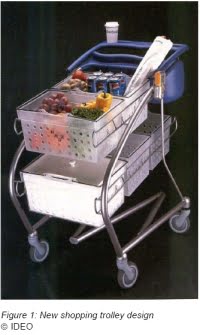The Ideo shopping cart and the halo effect. What is – really – good design?

Almost anybody interested in innovation knows about the Ideo process and the well-famed Ideo shopping cart video shot for ABC. It is indeed a staple for innovation seminars and a renowned example of faultless creativity methodology. In an ABC video, you will see the Ideo team challenged about the redesign of a ‘simple’ everyday object, the shopping cart.
Ideo, the shopping cart and the halo effect. What is – really – good design?
And the demonstration is compelling. Here’s an object we use on an everyday basis, almost universally from one end of the planet to the other, and one hadn’t even thought about making it more user-friendly.

Obvious, isn’t it? And the Ideo team, therefore, redesign the aforementioned trolley in less than two days. Impressive, all the seminar attendees stand up and cheer, here’s an awesome process that leads to compelling results (see the finished trolley in the above photograph)!
At least that’s what I thought too when I first saw that video, maybe a bit naively, until I read some critical articles for which I am providing links hereafter.
Afterthoughts include questions such as “why wasn’t this shopping cart deployed after the show and why can’t we find it in supermarkets?” and also “is the exercise real or is it artificial, namely at the beginning of the process when they start investigating the problem with cameras, are they doing it for real?”
The Ideo Shopping Cart and the Halo Effect
I was also pondering – whereas I have just started reading Rosenzweig’s latest opus – whether this wasn’t a case for a halo effect, i.e. “a tendency to make inferences about specific traits on the basis of a general impression” (The Halo Effect, p. 50).
Yes, the video looks nice, and the people seem brilliant and the process really seems to work fine. In just two days a new (supposedly) superior shopping cart was created but the real question is: what is really good design?
Is it about some design that looks good, or is it also about practicality, for instance? (What about all these boxes on the cart, are they really so convenient? Where do you store them? How do you pile the trolleys on one another, etc.)?
Is this design only aimed at the end user or is it also intended for shop owners? That’s a very significant question.
In the above video, the onus is on the team to develop a shopping cart that would be more convenient.
More convenient, to whom?
But more convenient to whom? Can we assume that shop owners aren’t worried about the cost of their trolleys, the way that they are stored, their lifespan? Besides, is the trolley issue the main issue, even for end users? For instance, would clients rather pay more for food stored conveniently in a designer trolley or pay less for food piled up in a chicken-wire box on wheels?
These are open questions, but chances are that the answer lies in the fact that one cannot find these trolleys in our stores.
Mind you, don’t jump to the conclusion that the Ideo process doesn’t work either. Judging on just one example would simply not be good enough. It would just be another halo effect.
Useful links
- Jim from Humanbeingcurious on an article of praise on the IDEO process
- Gene Smith on Ideo shopping cart: what has happened to the Ideo shopping cart?
- Steve Portigal on the ‘infamous’ ideo shopping cart example
- Wikipedia entry on Ideo
- The Ideo grocery cart report (pdf)
- Purchase the IDEO shopping cart Video from ABC ($39)
- The online patent description
- The IDEO shopping cart photo on Flickr
- Perceptron: A History of Neural Networks - 22/04/2024
- Networking and Growing Your B2B Business with LinkedIn - 20/04/2024
- Nobody understands how AI works - 23/03/2024





Hi,
my college had hired someone from IDEO to teach an innovation management class. I found your blog looking up innovation.
It is an interesting process at IDEO that includes many walks of industry professionals and Berkley graduate-school students. They do rigorous brainstorming, interviewing(open ended questions), observing behaviors of “pro-shoppers” to see how they efficiently manage their carts.
I’d like to answer some of the questions that you proposed:
“what is really good design? Is it design that looks nice, or is it also about practicality for instance?”
The IDEO team factored in engineering, cost, lifespan, and ergonomics, and others things I’ve probably missed. They are quick to prototype their ideas and quick to kill, and if worthy are combined with other ideas.
(what about all these boxes on the cart, are they really so convenient?
The boxes are very convenient. It was found by observing the efficient shoppers that they leave their cart in one place, and they hover around it picking up what they need. And placing it into the cart. The baskets can be removed and taken and replaced into the cart.
“where do you store them?”
You leave the baskets at the check-out area.
“how do you pile the trolleys on one another etc.). Is it design (only) aimed at the end user or is it also aimed at shop-owners too? that’s an important part. In the video the onus is on the team to develop a shopping-cart that would be more convenient. But more convenient to whom?”
You take the baskets out you place the items at the checkout. And here is the innovative part, the hangers for the baskets are then the holders(hooks) for the plastic bags. So when they are left out in the parklot, they wind can’t blow them around because they have to baskets.
“Can we assume that shop-owners aren’t worried about the cost of their trolleys, the way that they are stored, their lifespan?”
Actually they stack the same way a regular cart, fitting nicely because there are no baskets inside. Also bums will not steal the cart because there is no use for them without the regular shopping baskets of conventional carts. The carts actually targetted to shop owners that are worried about the cost of cart theft.
“Besides, is the trolley issue the main issue, even for end-users? For instance, would clients rather pay more for food stored conveniently in a designer trolley or pay less for food piled up in a chicken-wire box on wheels?”
That’s subjective. I myself don’t life shopping.